A preliminary fact-finding report on the Lambadug hydroproject disaster, May 2024
Himdhara Environment Research and Action Collective
On the morning of 10th May 2024 news reports emerged of a penstock burst in the 25 MW Lambadug Hydroelectric Project (HEP) having caused a flash flood in Multhan market in the Barot region of Kangra. The reports and videos on social media showed that several shops along with fields in Multhan were flooded with water gushing down the slope. The disaster had sent the villagers in a frenzy after waters entered the shops and homes but no casualties were reported. At night, around 8.45 pm, a rockfall and landslide occurred at the same spot (near the penstock) which further brought boulders and sludge down the slope onto the farms and the market located below. A three-member team of Himdhara Environment Research and Action Collective visited the area on 11th May 2024 to document the views of the affected people and observe the extent of damage and other impacts and look into the immediate issues surrounding the disaster.



Background (About the project and project area)
The Lambadug river in Barot Valley is a tributary of the Uhl, a 63 kms long river, which is part of the Beas River Basin. As part of its Hydropower power policy thrust, the government of Himachal Pradesh has proposed to install round about 40 to 50 HEPs with an installed capacity od close to 4500 MW on the river Beas and its tributaries (Number as per Directorate of energy 44 projects, as per the MoEF&CC website 51). Of these 19 projects are with installed capacity of 25 MW or greater which get covered under EIA notification 2006. About 11 of these 19 have been commissioned – the most recent being the Lambadug HEP commissioned in February/March 2024 as per locals as well as news reports.
A 25 MW project is generally assumed to be a “small project” but it involves significant underground as well as surface construction, which is why it had to go through a clearance process under the Union Ministry of Environment and Forests. The EIA report mentioned the following key components – a trench weir, intake channel and a desilting chamber, a 4.15 km long and 3.00 m diameter Head Race Tunnel through the right bank of river which leads the water to a underground Forebay and a Pressure Shaft/ Penstock to a surface Power House to generate power. The total estimated cost at the time of planning was 149 crores (Project EIA report, 2007-08).

The EIA report also mentioned that the study was conducted for the Himachal Pradesh Consortium of Power Producers (HPSEB). A public hearing for the project was conducted in the year 2008 (EC letter unavailable in public domain) and as per the Consent to Establish (CTE) given to the project by the HP Pollution control board in 2010, the project was accorded an Environment Clearance in 17.10.2008. The project was subsequently allotted to KU Hydropower, a (Special Purpose Vehicle) private firm incorporated on 17 June 2009.
Following this KU Hydropower contracted the project to Megha Engineering Infrastructure Limited (MEIL) to carry out the civil works of “drilling the head race tunnel, construction of a surface power house, and construction of other components for the 25 MW power plant like switch yard, penstock, surge pool, open channel, diversion weir, desilting chamber and as well as laying of 132 kV transmission lines.”


The boards at the project powerhouse site indicate that the MEIL is the main project proponent.
It is important to note that MEIL has a 100% share in the KU Hydropower as per the latest CRISIL ratings and thus MEIL may be considered as the main project proponent in the case.
The main affected villages in the alignment of the tunnel and whose land was acquired for the project muck dumping sites and other activities include Polling, Swar, Chherna, Khadi Nala, Andreli Malan, Bhujling, Luai Napota, Ropru, Multhan, Thuji and Barot. At the time of the initial surveys (2006) the total population of the affected area was approximately 6200.
The affected area is also home to rich floral and faunal biodiversity and falls in the Dhauladhar Wildlife Sanctuary. The area is also known for its riverine ecology and trout fisheries. The trout farm at Barot adjacent to Multhan market near the confluence of Lambadug and Uhl rivers was established in 1959. Infact, the Lambadug stream along with the Uhl was put in the negative list of the Government of Himachal Pradesh Fisheries department for insitu conservation of nearly 22 fish species found in these rivers. The local communities practice farming, livestock rearing, pastoralism along with earnings from emerging tourist activity.
The area is now also seeing horticulture and commercial cash crop farming as sources of income. The State Disaster Management Authority has identified Kangra as one among the five districts in the state as having ‘very high’ overall vulnerability to all disasters – especially landslides, earthquakes and floods. The area also has the nearly 90 years old Shanan reservoir (110 MW hydropower) located just downstream at Barot.
Key observations on the impacts and causes of the hydro-disaster
On the morning of 10th May 2024 at around 8.30 -9.00 am, as residents started moving about their daily chores and opening shops, there were whistles and screaming from the village habitation located above warning people of water approaching the village. A group of women along with Mala devi said, ‘We had just opened the shutters of our market when we heard people yelling to watch out. We just ran for our lives while some put the shutters down’. They watched a flood of water flowing down into the bazaar from between two settlements of Multhan village through the farms and fields.

The water kept gushing down, spreading through the bazaar located in the foothill on the left bank of the Uhl river. It started getting inside the shops and homes as people started moving to drier spots and safer spaces. A team of local people went up to the site and noted that the penstock pipe was leaking and indeed the flood was because of some damage in the project tunnel or penstock. As per one resident, the project proponents did not come to the site immediately even after repeated calls. ‘The police reached them for safety while we ran helter skelter not knowing whom to ask for help’. After a while JCBs were brought to clear out the area and allow the water to flow out but the seepage continued.
12 hours later as people were beginning to think about the first meal of the day after the day-long ordeal, at around 8.30 – 8.45 pm there was a rock fall and mudslide from the same area (near the penstock of the project). People said ‘Upar se chattan giri aur 10 se 15 minute tak pathar aur phir khoob saari mitti aur gaad niche aya’. The sludge from this slide further buried the fields which were planted with crops like potato, barley, garlic etc and then entered into the homes and shops located in the affected stretch. The affected structures at present have atleast 5 to 6 feet of muck and sludge in them. People whose shops and homes were affected by the flood (in a stretch of about 300 metres) said that they were not able to rescue any of their belongings or valuables.
On the 11th of May 2024 we observed that the water flow of about 14 to 16 inches was continuing from up the slope traveling through a deep channel formed between the two habitation sites of the village. The project authorities claim that they emptied out the reservoir and the tunnel as a safety measure on the first day itself and that the seepages that continue are not from the river or reservoir but accumulated from underground springs and aquifers which are flowing out.

Some images of the aftermath

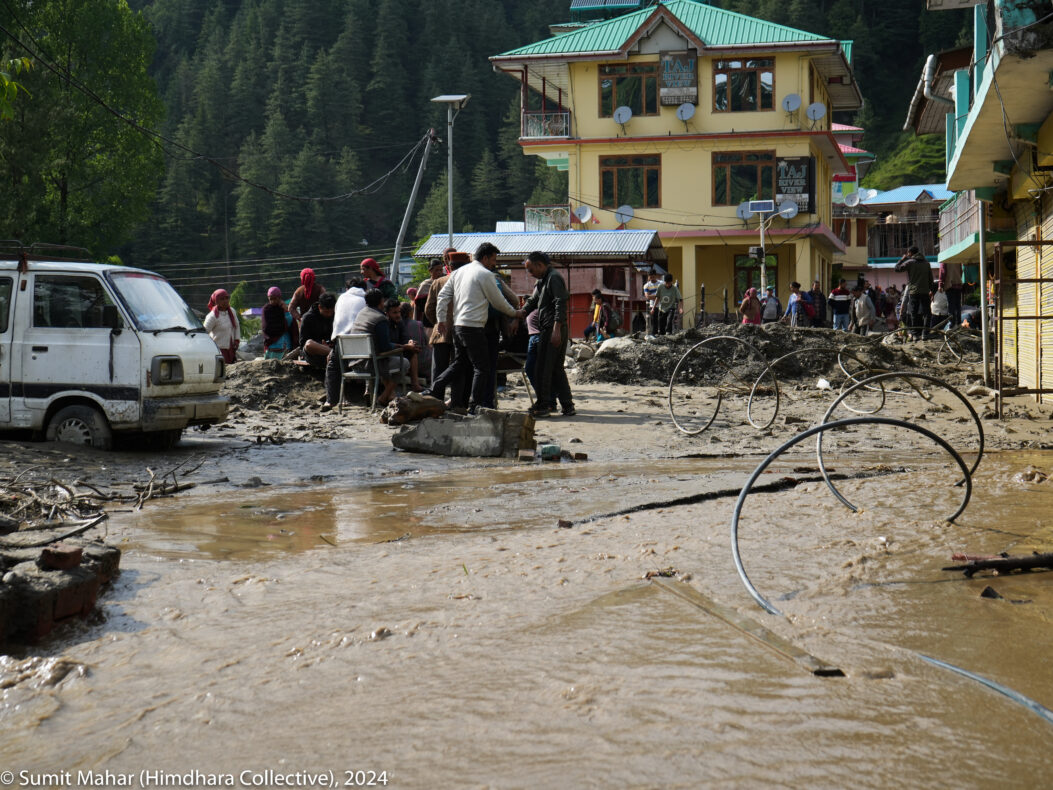






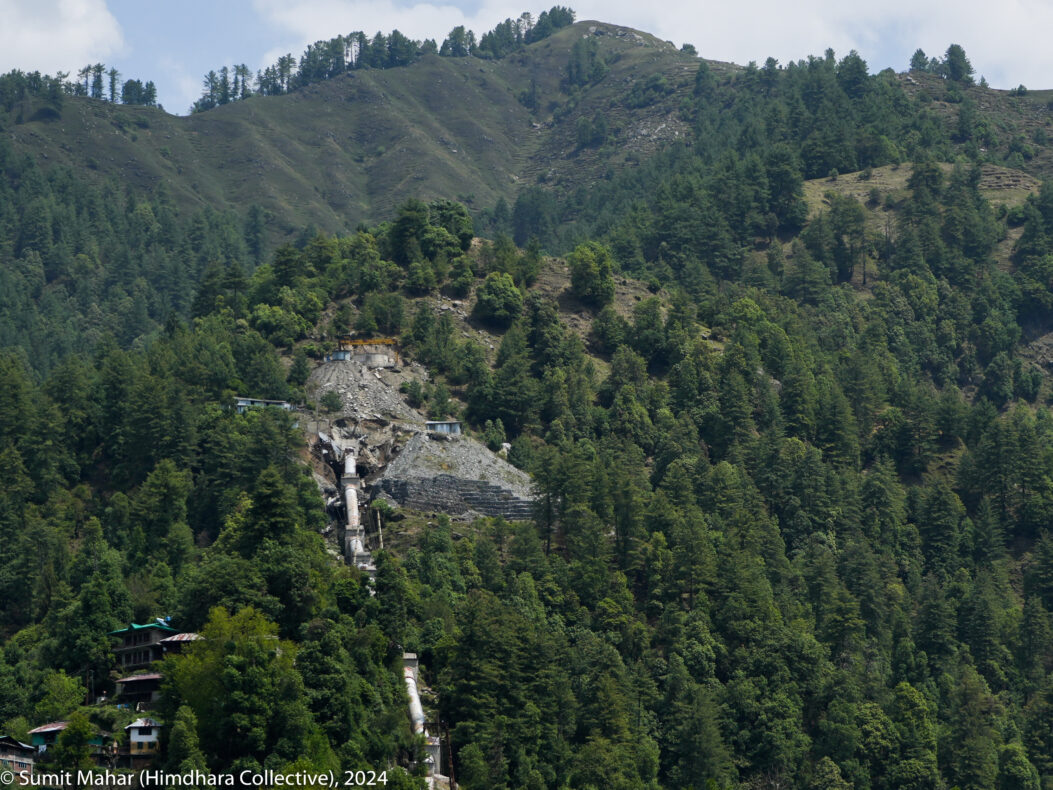
At the source of the hydro-disaster
The Multhan market is an elevation of 1850 metres and our team climbed up 150 metres to Kutlu where the forebay chamber is located and took pictures of the pressure shaft, penstock and forebay chambers. The area also had tin sheds (which may have been used by workers) and other heavy machinery piled up on the muck which was dumped around. Water seemed to be leaking from near the pressure shaft and the penstock below the forebay. A landslide-like situation was observed where the muck and debris was continuing to move downhill. The crown of the landslide that seems to have occurred at night, is just beneath the forebay. The abutments of the penstock were cracked and the foundation also seemed susceptible to further subsidence and sliding. Even remedial actions taken on the site, especially during rainfall, will be a threat for the inhabitants downhill and the impacted area may expand further.




The areas of the wide fields between the two settlements are covered in boulders and buried in muck with shreds of white plastic sacks apparently strewn throughout. This according to the women residents were from the sacks used as retaining walls by the project proponents. The residents had repeatedly demanded that proper concrete check walls be erected and that these sacks would serve no purpose and yet the project authorities had not paid heed.


Nearly 50 families – locals of Multhan – seem to have been impacted due to irreversible damage to either homes, fields and shops. Along with these there may be around 30 (or even more) who maybe tenants, outside residents, daily wagers working in hotels/homestay and other facilities in the market whose lives and livelihoods have been impacted. Apart from the immediate damages and threat from uncertainty, it is the long term impact of loss of livelihood and security which is the most critical issue that will need to be redressed.
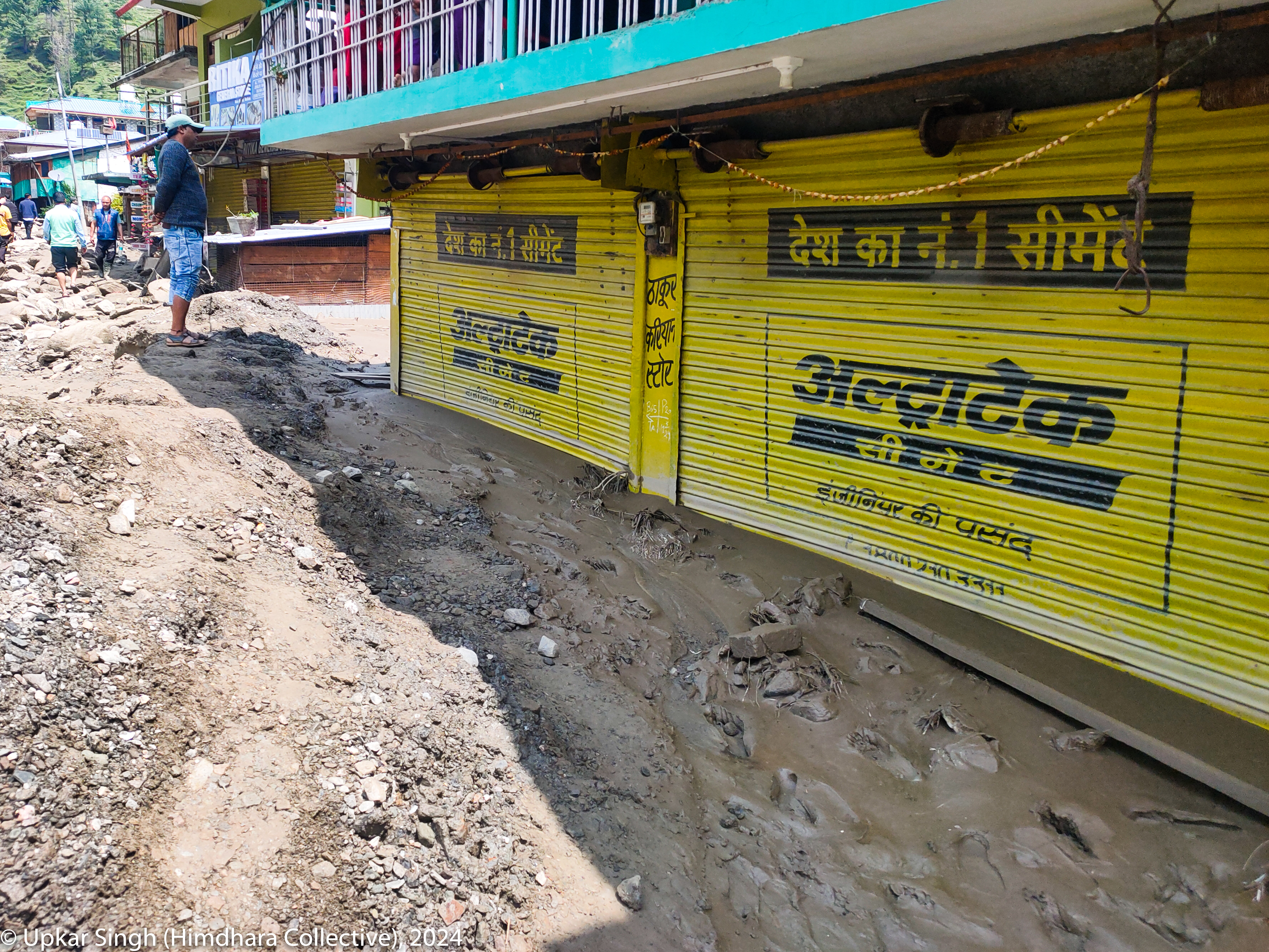
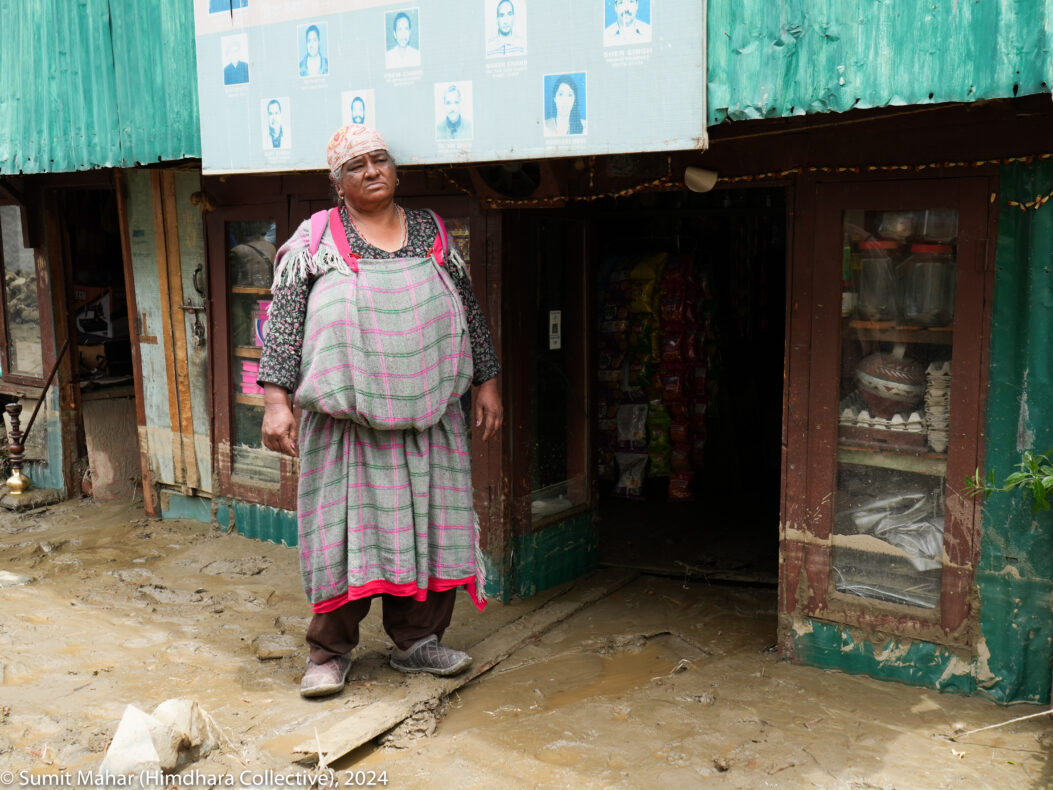

At present, the villagers fear safety and increase in seepages if there are rains, especially with the monsoon upcoming in about a month’s time. The GM of the project, Mr. Chauhan, during a meeting with the Sub Divisional Magistrate, Shri Devi Singh Thakur along with the affected people, said that they were waiting for machinery from Zozilla to be deployed to start the repair works but were unable to provide any solutions vis a vis. the continuous seepages. The project staff were waiting for senior staff to arrive on site to take any decisions but appeared helpless and clueless during the discussions on immediate remedial measures. Many of the affected people stated that it was shocking to hear that there were no emergency or disaster management plans in place to respond to such a contingency. ‘Forget that they do not have technical staff nor machinery to respond to this, they do not even have enough labour that can be put to task here’, community members complained.
An impact assessment was ongoing by the SDM and others officials on the 11th of May while our team was there. An immediate relief of Rs. 5000 was provided by the administration to each of the affected families. Some tenants and daily wagers mentioned that they had not been given relief – however, the administration has assured that the affected will be given one time relief. Living and food arrangements have been made by the project authorities in a hotel in a safe zone. The SDM said that the full compensation and rehabilitation would be the liability of the project proponents since this is a private project.

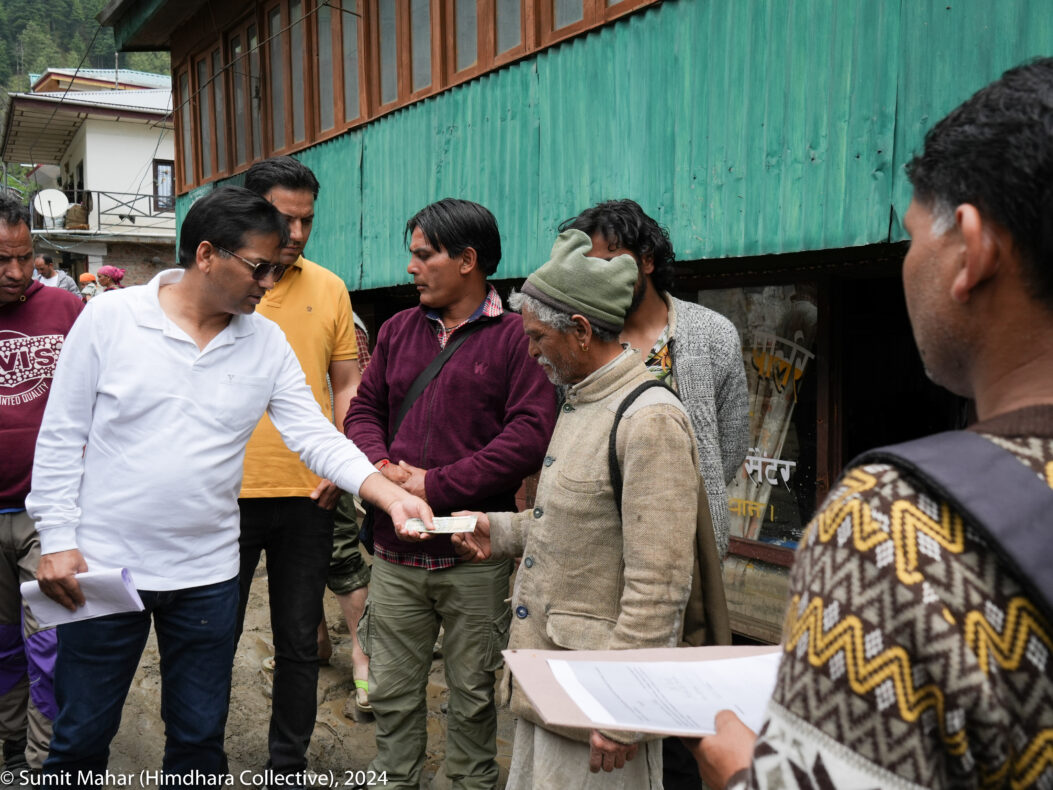
A team of officials from the agricultural department informed us that as per their assessment about 3-4 hectares (75 kanals) of fields/farms have been irreversibly destroyed (75 canals of land). According to Dr. Renu Sharma, just the cauliflower and cabbage nurseries gone would amount to about 18-19 lakh of loss. Apart from this there was barley, potato and mustard used not only for subsistence but also an income source. If calculated along with land and property damage, the losses are likely to run into crores.
The trauma induced impacts on women’s physical and mental health would also need to be assessed and support extended in the near future. We observed women working on the fields clearing out boulders, collecting valuables from the mucked up shops and homes, trying to rescue whatever belongings they could. They were most worried about their children as the future seems bleak for those who had spent their life earnings on building their homes and farms.


A police complaint on behalf of the affected people by Shri Jagdev Chand and it is reported that a criminal FIR was lodged by him at Baijnath Police station at -10/05/2024 AT 02.01 PM (FIR No. & U/S:-59/2024 U/S 336 IPC). The complaint mentions that during the testing of the project three months ago a similar leakage had taken place and that they had been assured by the project authorities that the same had been fixed. The affected people allege that they suspect use of substandard materials and compromises in the quality of the civil works. Residents also reported that several environmental impacts and violations were raised during construction vis a vis muck dumping, damage to local flora, crops and drying up of water sources in other affected villages along the alignment of the tunnel. These were raised in local courts and with the project authorities but there was little redressal. Nearly 6.3 kms of the Lambadug stream has been impacted (with loss of river flow) due to the tunnelling.
Affected people are demanding upfront and immediate compensation for the losses from the company. ‘We will not allow them to operationalise the road even if the loss assessment and payment of compensations is not carried out with urgency. We have been betrayed enough times and there is no trust that they will fulfill any promises later” said members of the Vyapar Mandal.
Unending series of hydro-disasters
The observations made in the case of the Lambadug project hydro-disaster reveals a clear case of extreme and criminal negligence by project executing agencies. A series of violations seem to have taken place from planning to execution that need detailed assessment. Additionally, we have observed non-transparency and lack of accountability with regard to the project information in public domain. We are shocked that an official report on the Ministry of Environment website has stated that the Environment Clearance letter for the project is not available. (See image from the official report of the Final Carrying Capacity Study for Beas river basin)
Further, the project seems to have undergone some changes in design from the time of clearances. However, there is no clarity on whether the relevant permissions were obtained from the Expert Appraisal Committee of the Ministry of Environment and Forests as well as Technical Clearances from the relevant agencies for these changes in the project. The EIA report is shoddy as is commonplace of such assessments. The report mentioned allotment of a measly 15 lakhs for its Disaster Management Plan and contained no disaster risk assessment as far as the tunnel and dam site were concerned.
Earlier in 2020, in the Uhl river the penstocks of the 100 MW Uhl III project at Lad Bhadol also similarly burst during testing leading to flooding of downstream power house. These incidences show that it is not just the mega projects of 100 MW and above that are cause of concern but also the small and medium projects that can have both short and long term disastrous impacts given the geological complexity and the climatic conditions of the Himalayan region.
The Himdhara Collective has earlier carried out similar investigations in the case of 100 MW Sorang Project, Parbati II project, 180 MW Bajoli Project (Chamba) and has also been documenting the short and long term impacts of hydropower proliferation in the state of Himachal Pradesh. Based on these reports several submissions have been made to authorities, specifically highlighting safety hazards in hydropower projects due to faulty siting, inadequate environment impact assessment studies and negligence and violation of safety guidelines and environmental norms by project proponents. These impacts and issues are further exacerbated and complicated by fast changing climatic conditions with increasing frequency and intensity of extreme events – a risk that nearly all planning and regulatory authorities have failed to take into account.
An entire region and people of Himalayan valleys like Barot, known for forest based pastoralism, agriculture livelihoods and local community led tourism have been compromised because of lackadaisical policies of central and state governments. The apathy towards the concerns of the local population that have been raised time after time is appalling. It is high time that the state government acknowledges the failure of hydropower projects and stop promoting them in the name of green energy. A project-wise holistic cost benefit analysis – with financial, economic, social and environmental aspects accounted for will reveal that the costs far outweigh the benefits in most cases.
Specific and Overall Recommendations
- A detailed Post Disaster socio-economic impact and needs assessment needs to be carried out. The Needs assessment study should not be left to the company and should be done by a competent team appointed by the State Government.
- A transparent, just process of compensation and rehabilitation with legal accountability must be set up with full participation and involvement of the affected people.
- Immediate and speedy action on Criminal Negligence and police complaints filed
- A high level and independent public inquiry that looks into the finances and books of accounts of the project proponents and all investors and executing companies – MEIL along with KU Hydropower, Andritz etc. MEIL, a company that has been under scrutiny for its involvement in the electoral bonds case as the second highest contributor needs an independent probe.
- Full disclosure of compliance and monitoring reports, clearance letters and departmental action taken reports from the time of grant of consent to establish to the project to the date of commissioning and after
- Invoke provisions of the Dam Safety Act 2022 for further inquiry about the potential threats of this project.
- A complete moratorium on further hydropower development and new projects of the capacity 25 MW and above
- A 360-degree safety audit of all existing operational hydropower projects in the state.
- Put in place mechanism for flood monitoring and warnings in coordination with IMD and CWC before the monsoons given the contribution of dams in the 2023 Himachal disasters.
- Full implementation of the Dam Safety Act 2022 and setting up of committees under the act to ensure accountability and grievance redressal mechanisms in cases of such disasters
- A financial audit of all hydropower projects in the state
Date of Visit 11.05.2024
Links to other local social media videos and news reports here
For more information contact info@himdhara.org
Interactive timeline | The ‘Clean Energy’ Hazardscape






